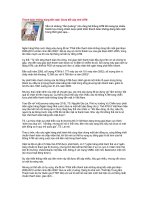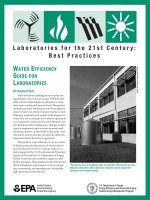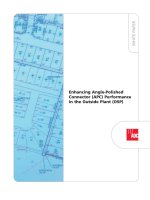Tài liệu Water environmental conservation for improved lihelihood in the Mekong delta, Vietnam doc
Bạn đang xem bản rút gọn của tài liệu. Xem và tải ngay bản đầy đủ của tài liệu tại đây (312.02 KB, 8 trang )
WATER ENVIRONMENTAL CONSERVATION FOR IMPROVED
LIVELIHOOD IN THE MEKONG DELTA, VIETNAM
Tran Thi Trieu
1*
,
Le Anh Tuan
1**
, Mira Kakonen
2
, Marko Keskinen
2
, Le Duc Toan
1
,
1
Department of Environmental and Water Resources Engineering (DEWRE)
College of Technology (CoT), Can Tho Unversity (CTU)
Campus II, 3/2 street, Can Tho City, Vietnam
Corresponding e-mail: *
, **
2
Water Resources Laboratory, Helsinky University of Technology
Tietotie 1E, 02150 Espoo, Finland
--- oOo ---
Abstract
Livelihoods of major population in the Mekong Delta (MD) highly depend on water resources of the
Mekong river, especially in Southern Vietnam, lowest part of the Mekong River Basin. While most of
Vietnamese farmers in MD use water from the rivers and canals for their daily drinking, irrigation,
domestic use, etc., effects of water environment to human life is more crucial. Vise visa, impacts of
human activities to water environment are also considered to ensure the sustainable development of
the MD.
A case study on water environmental conservation was done in Long An province, Vietnam. Long An,
part of the Plain of Reeds where is remarkable vulnerable area with flooding and saline intrusion, has
been suffering all water related problems including extra water, shortage of drinking water, saline
water, acid water, water pollution by upstream as well as on-stream users. The most water related
problems concerned by farmers in this area was access to get clean water.
Water environment conservation is one of the most urgent actions to
be done by increasing
awareness for local people. Integrated water resources management was considered. “Living
with flood” has been trend in the area. Sharing information between provinces is needed to
get synthetic data of water resources to adapt flood and orient it become “nice flood” from
which local people can utilize its benefit such as alluvia, natural fishes, soil improvement, …
Key words: livelihood, Mekong Delta, water environmental conservation, water-related problems.
1. Introduction
The Mekong River Delta (section of the delta in Vietnam), with its four million hectares of
lands for nearly 18 million of Vietnam inhabitants, is great potential for agricultural
production. The Delta supplied more than 50 percent of staple food and 60 percent of fish
production of Vietnam (Minh, 2000). However, the MD population, especial in the remote
areas, is facing to water problems from day to day. Long An province (part of the Plain of
Reeds as figure 1 and figure 2) suffer complexity of water related problems including not
only flood in the wet season but acid sulfate water, saline intrusion, lack of clean water in the
dry season. Water environmental conservation is an urgent action. Better access to water and
sanitation will improve the health and productivity of poor rural people and contribute to a
sustainable reduction of poverty in the target communities.
This case study aim to understand the most water related problems which link to livelihood of
grass root level in the area. The interview and group discussion with officers and farmers at
four levels are to comment participatory water environmental conservation for research areas
which help to improve living condition of the poor in the MD.
2. Area Description
Long An is located among the nine provinces of the Mekong Delta in the South Vietnam and
faces Ho Chi Minh City in the East. The area is 4,492 sq. km, lived with population of
1,392,300 habitants (2003) and Capital Tan An Town. It has 12 districts and as a part of Plain
of Reeds. The below map shows the position of Long An in the Mekong Delta.
Figure 1: Research site map in the Mekong River Delta
Figure 2: Long An map
3. Method
The survey was carried out at 4 levels including province, district, commune leaders and local
farmers. The method based on Participatory Rapid Appraisal (PRA) and Rural Rapid
Appraisal (RRA). At the province, district and commune levels, key informants from
Provincial Department of Agriculture and Rural Development (DARD), Department of
Natural Resources and Environment (DONRE), Women's Union, Youth's Union were invited
for interviewing. At the grass root level, two groups of 15-20 farmers took parts in group
discussion. To reach the objectives of the study, mapping, semi-structure checklists, problems
ranking were applied.
The result of survey was reported again to get feedback from four levels. The information
correctly reflected the situation and was the basis for water conservation. In additional, there
were 5-6 private interviews of farmers to confirm and deeply understand farmer ‘s problems
and aspiration on water conservation for their livelihood improvement.
4. Result and discussion
4.1 Water related problems with livelihood
4.1.1 Flood
The MD has 1.2 to 1.9 million hectares (ha) of land affected by annual flooding. In the year of
2000, Vietnam experienced one of largest and most damaged flood in 70 years (Minh, 2000).
Long An is affected flood from the Mekong river, it runoffs through Cambodia border, flows
down the Tien river and surmerges all main canals in the Plain of Reeds. This province is also
affected by flood from Vam Co Tay river. About 24,963 ha of paddy rice, 913 ha of
aquaculture, other crops as well as infrastructure were damaged by the flood in the year 2000.
The flood killed 78 persons including 39 children and lead 21,600 households to starveling
(Report of Long An DARD, 2000). Hamlet number 6, Tan Lap commune lost a lot by flood
before the year of 2000 because poor, homeless people lived in the field with unstable, small
houses. Children have to leave school in flooding season. Flood occurs in Long An from
August to October. In the year 2004, the curve of flood was very strange, it quickly increased
to the peak and drained. The officers explain that the flood was depend on rain in the
upstream areas. Deforestation for land use change has been listed as a root cause of increased
magnitude of flooding (Sitanon, 2004). Damages caused by flooding gradually decreases.
Table 1 shows damages caused by flood from 2000 to 2004.
Table 1: Flood damages in Long An
Damaged Items Unit 2000 2001 2002 2004
Rice (lost) ha 24 693 539 84 0
Cash crop ha 1 827 664 25 0
Aquaculture ha 913 381 - -
Infrastructure (collapsed bridges) unit 301 14 - 5
Death person 78 39 29 7
(Source: Long An DARD, 2005)
However, flood also brings benefit to people. Farmer need flood because it transfers alluvium
to the rice field, brings natural fishes, brings plankton which is food for fishes in cases and
pools, improves water and soil quality. Flooding flushes toxicity released from acid sulfate
soil. An extremely large amount of water is needed to dilute the leachate in order to prevent
negative impacts to the environment (Minh, 1998). Every people agreed that “Living with
flood” is the best way for the Mekong Delta sustainable development. Sharing information
among communes, districts and provinces aim to get synchrony water database and orient
flood to become “nice flood” which brings benefit to people.
4.1.2 Acid sulfate soil
Acid sulfate soil (ASS) occupies a large area of Long An. That is an serious problem in the
dry season for agriculture and aquaculture. Acid sulfate soil forms when soil containing iron
sulfite are exposed to oxygen (Minh et al, 1996). Disturbance of acid sulfate soil will increase
the acidity discharging into the water body.
To cultivate crop in the acid sulfate soil, there is necessary to reduce acid sulfate content by a
large amount of fresh water for flushing. Lime application is also a way for reduce acidity in
the soil but it will increase the production costs to the farmers. The leachate will ultimately
discharge into the river which may cause water pollution and kill aquatic life.
4.1.3 Saline intrusion
Saline intrusion affects to Long An through Vam Co Dong and Vam Co Tay Rivers. Vam Co
Dong river springs from Cambodia, meets the sea at Xoai Rap estuary, is affected by saline
intrusion up to the Cambodia border, including the Plain of Reeds. The most saline intrusion
was in 1977 up to Go Dau Ha. In year 1974, saline intrusion reach to Tan Thanh through Vam
Co Tay river (Thuan, 2004). The years with high saline intrusion were of years 1992, 1993,
1996, 1997, 1998. Peak of saline intrusion is in March yearly. In year 1996, the concentration
of salinity was over 3 mg/L.
Saline intrusion causes low yield of rice crop and damages the boat generators in the rivers
and canals. According to an officer in district level, it is very complex to control saline
intrusion. The dike system for prevention of saline intrusion will increase the harm of acid
sulfate soil to aquaculture and agriculture in the Plain of Reeds. Saline intrusion is one of the
principal limiting factors in agricultural production.
Most of the area is under mono-crop rice cultivation, where most of the poor provinces with a
high ratio of poor farmers are located. Shortage of drinking water is another constrain for
local people. In order to prevent further salinity intrusion, it is necessary to keep flows from
dropping too low (WB-ADB, 1996).
As a impact, the more drought leads the more saline intrusion. Saline intrusion period is about
3 months, from March to May yearly. At this period, almost no vegetables, kitchen-gardens
and other crops can stand. Many farmers, including women and their children have to move to
other places to earn their life. They become stipendiary. Some women do small trading, hired
labour. Farmers make use the time to repair their house, canal. In 1996, serious saline
intrusion went up to Hung Thanh, Duc Hoa districts. At that time, Vinh Hưng, Moc Hoa
districts were in highest shortage of irrigation water. Some of Northern districts had to sow
rice and pea nuts twice. Depending on the water supply capacity and land use pattern, there
are two major rice cropping systems in the Long An as figure 3:
(i) the single rice crop as Mua crop (rainfed rice); and
(ii) double rice crop as Dong Xuan crop (Winter-Spring) and He Thu crop
(Summer - Autumn) or He Thu crop and Mua crop.
The different in the rice yields in the wet and the dry seasons and the seasonal effects to the
livelihood is presented in table 2.
Figure 3: Cropping calendar, monthly rainfall and water demands in Long An
Note: VH: very high; H: High; M: Medium; L: Low
Table 2: Seasonal effects to the rice production and livelihood in Long An
Year
Spring
rice yield
(ton/ha)
Summer
rice yield
(ton/ha)
Effect of water regime to paddy field and livelihood
1996 4.80 3.02
• Early and long stayed saline intrusion (4 g/L)
• Lack of irrigation water
• Lost 10,497 ha of summer paddy rice
• Rural women and youth moved to the city
1997 4.70 3.32
• Still suffered effects of the harsh condition of 1996
1998 4.39 2.62
• Complicated climate, long dry season
• 11,000ha paddy rice of Moc Hoa, Tan Thanh districts
was lost by salinity and ASS
1999 4.18 2.97
• The 3
rd
rice crop was affected by ASS
2000 4.20 2.82
• Big flood
• 24,693 ha of rice lost
• 78 person were died by flood
2001 4.40 2.73
• Slowly drainage of flood
• Spring rice crop was later 1 month
• 10,675 ha of rice lost
2002 4.50 2.80
• Better climate for rice cultivation
2003 5.02 2.99
• Applying Integrated Pesticides Management (IPM)
• Improving varieties
• 80% of population have stable life
2004 5.08 3.25
• Excavating canals
• irrigated area increased to 40,000 ha
• Developed semi-dyke system to prevent early flood
• Improving water resources system management and
decentralizing management to district and commune
(Source: Long An DARD, 2005)
4.1.5 Water quality
Pollution of water resources caused by pesticides, herbicides and fertilizers in the past ten
years (An, 2000). Water quality issue impacts the people widely. Recent years, development
of agriculture adding the expanding population force Long An province to confront water
environmental problems. The beginning of the rainy season is the problematic period.
The main concern in the village level was the water quality, especially, the water supply for
domestic usage. For the interviewed villagers, water quality cause more worries than the
flood. The main cause of surface water pollution is acid sulfate soil, followed by agro-
chemicals and awareness of local people. According to directly interviewed local farmers,
some people have had bad habits: dropping dead animals, domestic solid wastes and chemical
containers to the water bodies. “Overhung toilets” or “Fish pond toilets” which contributed
micro-organism pollution to surface water, is still popular in hamlet No.6
The poor water quality leads to the water supply problems. Immediately need of hamlet No.6,
Tan Lap commune is water supply system. They can not use ground water because of very
high iron content. Many local people in Hamlet No. 6 and No.4 of Tan lap commune, Moc
Hoa district, use rain water in a haft of year, in the rest time they have to buy water from Tan









